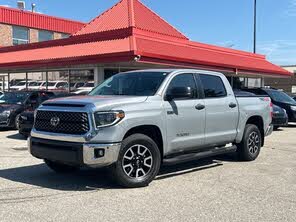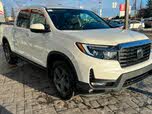2022 Honda Ridgeline vs 2021 Toyota Tundra
Overview | |
MSRP$34,125 | MSRP$38,140 |
Average price$47,591 | Average price$44,056 |
Listings47 | Listings46 |
Ratings & Reviews | |
User Reviews | User Reviews |
Expert reviews7.3 out of 10 | Expert reviews7.7 out of 10 |
Pros
| |
2021 Toyota Tundra Reviews SummaryIf you’ve been paying attention to any new truck ads, you’ll likely see items being promoted like a massive touchscreen or even a six-way multi-function tailgate. Like the rest of the automotive industry, the truck segment is charging ahead with many new innovations, incorporating new in-car technologies. But this seems like overkill for a segment whose main purpose is to tow, haul, and get work done. The window sticker for this Toyota Tundra says “2021,” but its design and underpinnings date back to the mid-2000s. It’s the oldest truck in a segment where companies are constantly one-upping and updating. So does the Tundra’s age hinder it among full-size pickups? Not really. In fact, it might be its best attribute. The Tundra might be an old design, but the engineers at Toyota have kept the Tundra relevant with some key updates and special editions. | |
2022 Honda Ridgeline Reviews SummaryHonda isn’t known for pickup trucks, but that means it brings a different perspective to the genre. The 2022 Honda Ridgeline is like no other pickup on the market. The Ridgeline isn’t just being different for the sake of being different, either. It uses the same unibody construction that gives crossover SUVs greater refinement than traditional models to offer increased comfort and better on-road handling than most pickups. Since the Ridgeline’s debut, the Hyundai Santa Cruz and Ford Maverick have applied the unibody concept to smaller compact pickups, creating a new niche, but the Honda is a larger vehicle that competes with existing midsize pickups like the Ford Ranger, Jeep Gladiator, Nissan Frontier, Toyota Tacoma, and Chevrolet Colorado/GMC Canyon twins. The Ridgeline debuted for the 2006 model year and the current second-generation version dates back to the 2017 model year. It got a facelift for 2021, so it carries over to 2022 essentially unchanged. In Canada, trim levels include the base Ridgeline Sport, midlevel EX-L and Touring, and the range-topping Black Edition, which is what we sampled for this review. | |
No video found | |
Popular Features & Specs | |
Engine5.7L 381 hp V8 | Engine3.5L 280 hp V6 |
Drive Train4X2 | Drive TrainAWD |
Seating Capacity6 | Seating Capacity5 |
Horsepower381 hp @ 5600 rpm | Horsepower280 hp @ 6000 rpm |
MPG City13 | MPG City18 |
MPG Highway17 | MPG Highway24 |
Engine | |
Engine Name5.7L 381 hp V8 | Engine Name3.5L 280 hp V6 |
Torque401 lb-ft @ 3600 rpm | Torque262 lb-ft @ 4700 rpm |
Horsepower381 hp @ 5600 rpm | Horsepower280 hp @ 6000 rpm |
Drivetrain4X2 | DrivetrainAWD |
Fuel Economy | |
MPG City13 | MPG City18 |
MPG Highway17 | MPG Highway24 |
Interior | |
Seating Capacity6 | Seating Capacity5 |
Safety | |
Front Crash Overall4 | Front Crash Overall5 |
Side Crash Overall5 | Side Crash Overall5 |
Dimensions & Capacity | |
Bed Length78.7 in | Bed Length64.0 in |
Cargo Space | Cargo Space7.3 cu ft |
Curb Weight5170 lbs | Curb Weight4436 lbs |
Height76.0 in | Height70.8 in |
Length228.9 in | Length210.2 in |
Width79.9 in | Width78.6 in |
Wheelbase145.7 in | Wheelbase125.2 in |
Maximum Payload1730 lbs | Maximum Payload1583 lbs |
Number of doors4 | Number of doors4 |
Maximum Towing Capacity10200 lbs | Maximum Towing Capacity5000 lbs |
Standard Towing Capacity10200 lbs | Standard Towing Capacity5000 lbs |
Overview | ||
MSRP | $34,125 | $38,140 |
Average price | $47,591 | $44,056 |
Listings | ||
Ratings & Reviews | ||
User reviews | ||
Expert reviews | 7.3 out of 10Read full review | 7.7 out of 10Read full review |
Pros & cons | Pros
| |
Summary | If you’ve been paying attention to any new truck ads, you’ll likely see items being promoted like a massive touchscreen or even a six-way multi-function tailgate. Like the rest of the automotive industry, the truck segment is charging ahead with many new innovations, incorporating new in-car technologies. But this seems like overkill for a segment whose main purpose is to tow, haul, and get work done. The window sticker for this Toyota Tundra says “2021,” but its design and underpinnings date back to the mid-2000s. It’s the oldest truck in a segment where companies are constantly one-upping and updating. So does the Tundra’s age hinder it among full-size pickups? Not really. In fact, it might be its best attribute. The Tundra might be an old design, but the engineers at Toyota have kept the Tundra relevant with some key updates and special editions. | Honda isn’t known for pickup trucks, but that means it brings a different perspective to the genre. The 2022 Honda Ridgeline is like no other pickup on the market. The Ridgeline isn’t just being different for the sake of being different, either. It uses the same unibody construction that gives crossover SUVs greater refinement than traditional models to offer increased comfort and better on-road handling than most pickups. Since the Ridgeline’s debut, the Hyundai Santa Cruz and Ford Maverick have applied the unibody concept to smaller compact pickups, creating a new niche, but the Honda is a larger vehicle that competes with existing midsize pickups like the Ford Ranger, Jeep Gladiator, Nissan Frontier, Toyota Tacoma, and Chevrolet Colorado/GMC Canyon twins. The Ridgeline debuted for the 2006 model year and the current second-generation version dates back to the 2017 model year. It got a facelift for 2021, so it carries over to 2022 essentially unchanged. In Canada, trim levels include the base Ridgeline Sport, midlevel EX-L and Touring, and the range-topping Black Edition, which is what we sampled for this review. |
Video | No video found | |
Popular Features & Specs | ||
Engine | 5.7L 381 hp V8 | 3.5L 280 hp V6 |
Drive Train | 4X2 | AWD |
Seating Capacity | 6 | 5 |
Horsepower | 381 hp @ 5600 rpm | 280 hp @ 6000 rpm |
MPG City | 13 | 18 |
MPG Highway | 17 | 24 |
Engine | ||
Engine Name | 5.7L 381 hp V8 | 3.5L 280 hp V6 |
Torque | 401 lb-ft @ 3600 rpm | 262 lb-ft @ 4700 rpm |
Horsepower | 381 hp @ 5600 rpm | 280 hp @ 6000 rpm |
Drivetrain | 4X2 | AWD |
Fuel Economy | ||
MPG City | 13 | 18 |
MPG Highway | 17 | 24 |
Interior | ||
Seating Capacity | 6 | 5 |
Safety | ||
Front Crash Overall | 4 | 5 |
Side Crash Overall | 5 | 5 |
Dimensions & Capacity | ||
Bed Length | 78.7 in | 64.0 in |
Cargo Space | 7.3 cu ft | |
Curb Weight | 5170 lbs | 4436 lbs |
Height | 76.0 in | 70.8 in |
Length | 228.9 in | 210.2 in |
Width | 79.9 in | 78.6 in |
Wheelbase | 145.7 in | 125.2 in |
Maximum Payload | 1730 lbs | 1583 lbs |
Number of doors | 4 | 4 |
Maximum Towing Capacity | 10200 lbs | 5000 lbs |
Standard Towing Capacity | 10200 lbs | 5000 lbs |

By: CarGurus + AI
At CarGurus, our team of experienced automotive writers remain at the heart of our content operation, conducting hands-on car tests and writing insightful guides that are backed by years of industry experience. To complement this, we are harnessing AI to make our content offering more diverse and more helpful to shoppers than ever. To achieve this, our AI systems are based exclusively on CarGurus content, ratings and data, so that what we produce is both unique to CarGurus, and uniquely helpful to car shoppers.









































